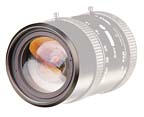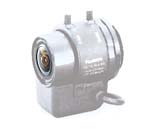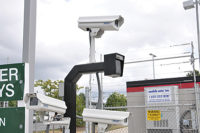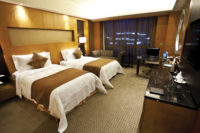
Although they are sometimes taken for granted, camera lenses are a critical element of video surveillance systems. Choosing the right lens and installing it properly can mean the difference between identifying and prosecuting a perpetrator, or between a happy and unhappy client – and with the wide range of lens choices available in today’s market, the selection process often can be the most complicated part.
Dome or Box Cameras
One of the reasons lenses sometimes are taken for granted is that many of today’s video cameras, particularly today’s increasingly popular dome cameras, come with a lens already built in. “A dome camera has the ability to blend in with its surroundings; it’s aesthetically pleasing,†notes Adam Colombo, regional sales manager for manufacturer Fujinon CCTV of Wayne, N.J.Before choosing a dome camera, however, systems integrators should verify the image quality of the built-in lens. One way to do this is to set up several camera models in a bench test to determine which one has the best image quality, advises Roger Fox, founder of Remote Video, a group of systems integrators with offices in Irvine, Calif., and several other major U.S. cities.
Depending on the installation, traditional box cameras, which require the purchase of a separate lens, can sometimes offer more flexibility than cameras with built-in lenses. A high-power zoom lens, for example, cannot easily fit into a domed housing. Additionally, some clients don’t want a camera that blends in with its surroundings, instead preferring people in the coverage area to know they’re under observation.
Fixed or Vari-focal
Once the camera type has been selected, the next choice is whether to use a fixed, vari-focal or zoom lens. All three lens types can be built in or purchased separately from the camera.Fixed lenses have a specific focal length, measured in millimeters. A typical fixed lens has a focal length of about four millimeters and provides a wide-angle view. Installers can gauge how large an area a lens will cover by consulting a chart provided by the manufacturer. Many manufacturers offer such charts on-line, or installers can use a tool that resembles a circular slide-rule. Some distributors handle such calculations for their customers.
To determine the right lens, installers must consider how far away and how wide an angle the client wants to see. Based on this information, the lens selection chart will recommend a lens of a specific focal length. When purchasing the lens separately from the camera, installers also must know the camera format, which is measured by the size of the image sensor. Many of today’s cameras are 1/3-inch format, but 1/4-inch and 1/2-inch formats are also available. A final consideration is the type of mount. Most of today’s box cameras are CS-mount, although C-mount lenses are also available.
Although lens selection charts are useful, installers shouldn’t rely on them totally, cautions John Evans, a system support representative for security distributor ADI in Louisville, Kentucky. “There’s more to it than using a chart,†Evans notes. For example, if a client wants facial recognition, the installer should select a lens that provides an image in which a person’s face fills about a third of the picture, Evans advises.
Because clients sometimes have difficulty recognizing their coverage needs, systems integrators increasingly are turning to vari-focal lenses, which can be adjusted to provide a variety of focal lengths, typically in the range of 5 to 50 millimeters. Initially such lenses were more costly than fixed lenses, but the prices have come down substantially. Manufacturer Speco recently discontinued its fixed focal length CS-mount lenses because there was so little price difference that most installers were purchasing vari-focal alternatives. “It doesn’t make sense to lock yourself into fixed lenses,†notes Speco vice president Gary Perlin.
But one manufacturer of fixed-focal-length lenses disagrees. According to Steve Davies, sales manager for Pentax Security Systems in Mississauga, Ontario, fixed lenses provide superior image quality to vari-focal lenses, which work best in the middle of the range. “It’s almost impossible to be sharp from one range to another,†argues Davies, adding that installers may experience some image softness with vari-focal lenses.
To help ensure the best possible image quality when using vari-focal lenses, installers should take care to firmly tighten the lens in place once they have determined the proper setting and confirmed that the image is in focus. Some lenses have set screws to simplify this task.
Zoom Capability
Like vari-focal lenses, zoom lenses also have adjustable focal lengths – but zoom lenses have an added edge not provided by vari-focal lenses. “The difference between a vari-focal and a full-fledged zoom is that you have to refocus after you change the focal length on a vari-focal lens,†Davies explains. “A full fledged zoom maintains focus throughout the range.â€The ability to stay in focus has made zoom lenses the preferred choice for border patrols and other government organizations that need to track a suspect’s movements, notes Colombo of Fujinon. Such capability doesn’t come for free, however. Zoom lenses cost about three times as much as a typical vari-focal lens, Colombo says.
Before using a zoom camera, it’s critical for installers to back-focus the lens according to the manufacturer’s instructions. The usual process involves zooming all the way out to the longest focal length, focusing the device on a distant object and then zooming in to the shortest focal length, making sure that the image stays in focus. Some manufacturers will back-focus their cameras as a service for customers, sometimes at no charge.
Dome cameras with built-in zoom lenses typically include pan-and-tilt capability and can be controlled remotely by an operator or through pre-sets that can be triggered according to a schedule or in response to a particular event, such as a nearby door being opened. The domed housing protects the camera and makes it difficult for perpetrators to determine which way the camera is pointing.
Other factors to consider when selecting a lens are the image resolution required and the lighting conditions in which the lens will be used. For high-security installations, installers may want to consider high-resolution megapixel lenses. Although these lenses can cost about 30 percent more than traditional lenses, they provide greater image detail, such as the ability to read license plates.
Another factor that can affect image quality is the F-stop, or aperture, of the lens. Lenses with lower F-stop numbers have a greater ability to let light in, which can improve picture quality. A good F-stop rating can be particularly important for applications where the ability to accurately capture color is critical, notes Scott Hamasaki, director of sales and marketing for International Space Optics, SA of Irvine, Calif., the company that offers lenses under the Rainbow CCTV brand. Hamasaki cites the example of casinos, where the client may need to be able to correctly identify the color of each chip.
Using aspherical lenses is another method of improving image quality by boosting the light gathered, notes Perlin –although another manufacturer disagrees. “Aspherical lenses tend to affect the field of view and give a distorted view,†notes Michael Ames, manager of network video solution sales for Canon USA of Lake Success, N.Y. “They tend to throw the user off because objects appear to be in a different location.â€

Focusing and Walk-testing
Once installers have selected the lens they want to use, the next step is to ensure that it is in focus and that the images it provides are appropriate for the installation. When focusing a camera, Evans advises installers to make sure they adjust it under the lowest light conditions it will experience. “Objects that are in focus during the day may fall out of focus at night,†Evans says. If a lens is installed during daylight conditions, one way that installers can simulate nighttime is to use a filter. Some installers use welding glass –the same type of glass used by welders to protect their eyes –as a filter, Evans notes. Alternatively, some manufacturers offer similar products that have been designed specifically for use by the video surveillance industry.To ensure that the camera is aimed properly and that the lens is displaying an appropriate field of view, there is no substitute for viewing the image on a video screen. A useful alternative here is to purchase a field monitor – a small lightweight monitor that can be taken to the job site and even carried up onto ladders. “A field monitor is helpful because you can get most things done without having to have two people,†notes David Craig, technical manager for International Space Optics.
Where an additional technician will be needed, however, is for walk-testing. Ames advises installers to check the image under a range of conditions. “Try to think of every possible option,†he says. “Think about all the doorways and hallways. One of the most common mistakes happens when shooting with a window or a door in the background. When you do a walk-through, you should simulate people walking outside the window or through the door as well.†Such factors can be particularly critical with pan-tilt-zoom cameras that are programmed to follow motion, he says.
Sometimes the best way to optimize the field of view is to move the camera itself. Recognizing this, technicians at Esco Communications, an Indianapolis-based systems integrator, sometimes attach a camera to a pole that can be easily moved around a room. “The customer can look at the view before we make it permanent,†notes Mike Lowe, Esco vice president of corporate and commercial accounts. “We ask the customer if this looks like what they want to see. If we show them the view using the temporary set-up, there’s no doubt about the final result.â€
One final installation tip: Installers should take care not to get fingerprints on any lenses. The best way to prevent this is to keep the lens cap on until the lens is connected to the camera body, Davies says. But just in case smudges should occur, he advises, “Always have a high quality cleaning cloth that works in any weather.â€
Sidebar 1: SIX Tips for a Great Lens Installation
1 When focusing a camera, make sure to adjust it under the lowest light conditions it will experience.2 If a lens is installed during daylight conditions, one way that installers can simulate nighttime is to use a filter.
3 To ensure that a camera is aimed properly and that the lens is displaying an appropriate field of view, view the image on a video screen or a portable field monitor.
4 One of the most common mistakes happens when shooting with a window or a door in the background. When you do a walk-test, simulate people walking outside the window or through the door.
5 Attach a camera to a pole that can be easily moved around a room so your customer can look at the view before choosing a permanent location for the camera.
6 Keep the lens cap on until the lens is connected to the camera body to avoid getting fingerprints on the lens.
Side bar 2: On-line Reference Tools
- Several manufacturers offer on-line tools for selecting the right lens for a particular video surveillance application. Here are the URLs for three of these:
http://www.rainbowcctv.com/lens_calc.htm
http://www.specotech.com/salesreps/LensCalculate.asp
http://opd.usa.canon.com/html/industrial_bctv/ERC/index.html - In addition, Fujinon offers a useful reference document that explains lens terminology such as F-stops and field of view at:
http://www.fujinoncctv.com/pdfs/cctv0904/data_terminology.pdf


